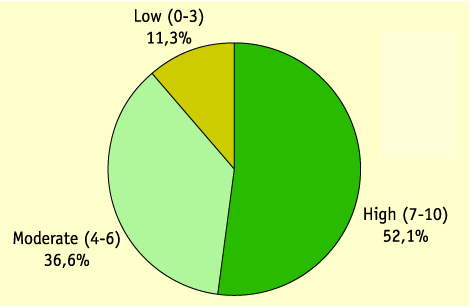
| Sociolingüística catalana |
| Insurance companies and language uses, attitudes and services, by Institut DEP and Joan Solé i Camardons | ||||
| CONTINUA |
| 2.6. Internal language norms
A slight majority of companies prefer not to draw up their own norms on the use of Catalan (55.6 %); however, 44.4 % admit to having an informal one that is not set down as such in a document. Table 6. Please
summarise these norms
Catalan and staff recruitment Almost all UCEAC members evaluate knowledge of Catalan in recruitment procedures for staff whose duties include dealing with the public. Knowledge of Catalan is considered to be an essential requirement for forming part of the workforce (68.0 %), rather than a mere merit (27.8 %). Only 4.2 % of companies in this sector do not consider this criteria necessary. 3.1. Progress and evaluation of the use of Catalan When questioned at interview, insurance company managers thought that the use of Catalan had increased in the last three or four years in 75 % of UCEAC companies. Of these, 41.7 % had undergone a slight increase and, in 33.3 %, the change had been more substantial. The two main reasons for the increased use of Catalan in the insurance company sector are: the incorporation of new staff educated in Catalan (42.6 %), and the rising social and market demand for the use of Catalan (42.6 %). The main reason for the stagnation in the use of Catalan over recent years in this business sector is the lack of change in company structure and policies (73.3 %). Evaluation of the use of Catalan Over half of UCEAC companies rate the use of Catalan in their organisations as high (51.4 %), 36.1 % evaluate their use as moderate, and only 11.1 % consider that they hardly ever use it. On a scale of 0 to 10 (where 0 is very low and 10 is very high), the average use of Catalan is rated at 6.6. The main reason for the extended use of Catalan in these companies is that it is the main language of their employees (40.5 %). Despite the positive evaluation, Catalan is not used exclusively because it often alternates with Spanish at internal and external level (35.1 %) and because much of the documentation is drawn up mainly in Spanish (21.6 %). The majority of companies with a moderate use of Catalan (65.4 %) explain this by the indistinctive use of Catalan and Spanish in their organisation. The second most common reason for this modest use lies with the fact that Spanish is the vehicular language of the organisation and of the staff that form part of it (26.9 %) in cases where organisations depend on central offices outside Catalonia (19.2 %). Companies that evaluate their level of Catalan use as low offer three main reasons for this: the centralisation of the system outside Catalonia (25 %), the use of both Catalan and Spanish (25 %), and the fact that Spanish is the main language of their staff and organisation (25 %). Figure 3. How do you rate the use of Catalan in your company?
|
|||||||||||||||||||||||||||
